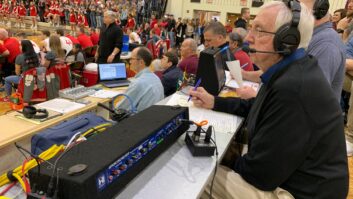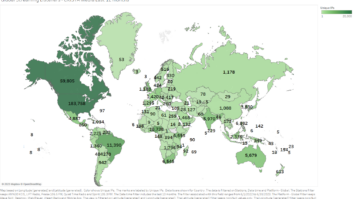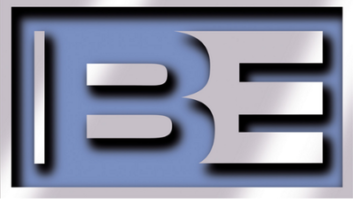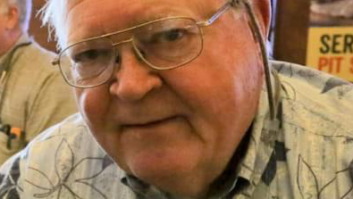Update: Tom Osenkowsky passed away in late August. –Paul McLane
Today I’m tipping my hat to a friend and colleague in the Radio World family, Tom Osenkowsky, in recognition of an accomplished career.
You may know him from his technical consulting work, articles in Radio World, a chapter in an SBE handbook about disaster planning, presentations to the NAB Broadcast Engineering Conference, or SBE and IEEE Broadcast Technology Society events.

Tom Osenkowsky is shown with a Piper Warrior belonging to his friend and fellow engineer Paul Shulins. The photo was taken by Russ Mundschenk.
One good reason to make note of Tom’s career right now is that the 11th edition of the National Association of Broadcasters Engineering Handbook is fresh in print. This is a particularly important industry reference, and Tom has had a hand in the two most recent editions as associate editor and a chapter co-author.
The other reason is that he is terminally ill. Tom has been actively battling lymphoma, multiple myeloma and stage IV renal failure since December of 2014. In July of this year, due to the lack of available options and low blood counts, he terminated his cancer treatments. As I write, he is in the care of Regional Hospice & Palliative Care in Danbury, Conn.
“I was proud to be the first patient in New England to beta test a new chemo, Darzalex, which lowered my Creat[inine] to where I did not require dialysis,” he told me.
“Unfortunately it did not lower other critical anomalies in my blood. Other patients are benefiting from the data gathered during my stay in the Observation Floor at Danbury Hospital.”
Tom has been an absolute inspiration to me in the direct and honest way he has confronted this prognosis. He stated his outlook frankly: “I do not have any dependents, and cared for my parents up to their final breaths. It is time to go.”
A RANGE OF RF WORK
I asked him to reflect on memories of his broadcasting career; replying by email, he was typically matter of fact. He said it began by accident during high school.
“I started as a news stringer for local station WINE, Brookfield, Conn.,” he said. “After attending Central Connecticut State College for a year, I got married and worked for Automation Industries Inc. in Danbury, Conn. I learned a lot of the manufacturing process.”
The opportunity arose to become chief engineer of then-WOWW(AM) in Naugatuck; he worked there until he was hired — despite a lack of FM experience — by the late Bill Patrick at WAVZ(AM)/WKCI(FM) in New Haven.
“A little over a year later our Alford directional FM antenna was destroyed by falling ice, and I negotiated a mutual consent agreement with a neighboring adjacent-channel station which allowed us to operate non-directionally,” Tom remembers. “I designed a two-bay antenna at increased height on the WTNH(TV) tower, which allowed a very substantial increase in coverage.”
He also served WRCQ/WRCH as chief engineer. He did contract engineering on a long-term basis for WNHU, WQAQ, WVOF and WNTY. He performed engineering in St. Maarten and Aruba, as well as across the United States for AM/FM clients. Tom wrote computer programs to assist in the design and analysis of AM antenna and coupling systems to allow broadband operation with increased fidelity and coverage.
“One of the more interesting projects was to design an AM/FM reception system using multiple tuners for a client who monitored and recorded broadcast stations for the purpose of reconstructing their program and music logs,” he said.
“In this case reception was as important to their business model as transmission was to a broadcast station. I specified the required antennas, equipment and installation procedures and was able to meet their needs. The sole exception was a directional AM whose array placed a null directly over their offices. Direct reception was not possible in that case and an alternative reception method was required.”
Another interesting and precedent-setting project was convincing the FCC to recognize the effect of a tower on a non-directional FM antenna.
“My client relocated their FM to a NCE TV tower, and a co-channel neighbor objected. I did range tests and we agreed to specifically mount our antenna in such a manner as to minimize signal toward their market and remain classified as a non-directional station. The station has since vacated the site and the objecting station was sold.”
“GENUINE COMPASSION”
An article like this can struggle to capture the personality behind the deeds. I asked colleagues to share their own thoughts.
Paul Shulins said Tom has made countless contributions. “Never afraid to speak his mind when he feels that broadcasters can benefit from his comments, he has on numerous occasions either made us rethink issues, or has brought us a different perspective that was never previously considered.” He called Tom not only an excellent engineer but a wonderful role model and human being.
NAB’s David Layer worked with him on the handbook. “He was truly the perfect man for the job, he had the right engineering knowledge and the right contacts and acquaintances in the broadcast engineering community to help find and recruit the right authors for our chapters, to work with the authors on developing the content, and to massage that content into the outstanding material that has become the hallmark of the NAB Engineering Handbook publication.” As Layer put it, no one gets wealthy from this work, it is more a labor of love
I learned that Tom is well respected in the consulting community.
Ron Rackley, who has known him for more than three decades, told me, “Tom has an honest intellectual curiosity to go along with his rather intense personality that has always driven him to excellence.”

Tom Osenkowsky tuned a Gates FM-10H at WKCI in Hamden, Conn., circa 1978, above, and worked in St. Maarten at studios of PJD2/PJD3 in a later undated photo.

They met when Ron was curriculum coordinator and a lecturer for the old AM Directional Antenna Seminar at NAB headquarters in Washington in the 1980s. “He and I sat at lunch one day and discussed how some AM directional antenna patterns can be reverse-engineered into their component pairs so that alternative designs for the same pattern shape can be evaluated for optimal performance,” Ron recalled.
“I explained how it would require solving a complex system of simultaneous polynomial equations, something I had never attempted mathematically, favoring solution by simpler iterative analysis myself. A few weeks later, a floppy disk arrived with a program to reverse-engineer patterns using the math I had described. Tom had taught himself the math and written his ‘moding’ software for rapid solutions with it.” Ron was impressed.
Perhaps the person who best described Tom’s personality, as I’ve experienced it, is Gary Cavell. He only got to know Tom while working on the handbook. “But somehow, jumping into this project with him was like continuing a long conversation with someone I had known for years.” Tom, he said, undertook the editing and management of more chapters than anyone, “and did so with resolute dignity while quietly coping with the greatest challenge of his life.”
He took note of Tom’s “personality, intelligence, humor, sense of justice and firm convictions,” and added, “He does not suffer fools easily, and will not shy away from a confrontation if someone is being treated unfairly in his presence.”
He captured something that I, too, noticed. “I suppose he can be intimidating to some, due in part to a seemingly prickly ‘New York’ personality, but there is a serious undercurrent of warmth and genuine compassion that unfailingly comes through. I especially enjoy his sharp, often ‘off the wall’ humor that he seamlessly interjects into situations, typically when sorely needed.”
I echo this. Maybe as a born New Yorker, I’m well suited to finding Tom’s deadpan, puckish sense of humor so appealing.
SMOKIN’ TOM GARY
So what does this engineering veteran feel is the most notable recent development in radio broadcast engineering? Tom points to the integration of computers, audio over IP, automation and syndication in studio and transmitter facilities.
“This is somewhat due to the newly introduced methods of delivering entertainment, news, sports, weather and information to the public,” he said. “Smartphones, iPhones and similar devices have replaced portable transistor radios. They are also interactive with the owner.”
Over-the-air broadcasters have attempted to reduce operating expenses by eliminating local talent, he said. Stations have consolidated and some have surrendered their licenses. “The face of broadcasting has changed and so have the audience and their expectations. The advertising dollar has been divided in many ways, leaving OTA broadcasters with a lesser share than previous times.”
Meanwhile, on the personal level, his closest friend has been trying to help out as best he can. Russ Mundschenk met Tom Osenkowsky on CB radio in 1969; he considers Tom not only his lifelong buddy but his mentor, even though they are the same age.
“We have followed each other through the same studios and transmitter sites for the past 48 years. I stood up for him when he married Peggy and am still there for him today.
“We started out as WLAD announcers filling the shifts no one else wanted. ‘Smokin’ Tom Gary’ went on to more lucrative pursuits as chief engineer of that Danbury, Conn., station and WKCI/WAVZ in New Haven. There, he made both stations the loudest on the dial by cobbling together one of the first multi-band audio processors with a Crown crossover, dbx AGC’s and an Optimod 8000.”
Tom, Russ recalled, was also responsible for rebuilding many AM arrays in the Northeast including daytimer WNTY in Southington, Conn., and developed a simple DOS-based method-of-moments software suite that others have found very useful.
This July, after lunch and a flight in Paul Shulin’s Piper Warrior, Tom gave Russ the same Radio Shack DX-150 that Russ used to learn Morse Code in 1969.
Thank you, Tom — for your contributions to radio, for your work in Radio World, for your friendship these many years, and for your fortitude and inspiration. It shouldn’t require an illness to tell you that we’re proud to know you.












